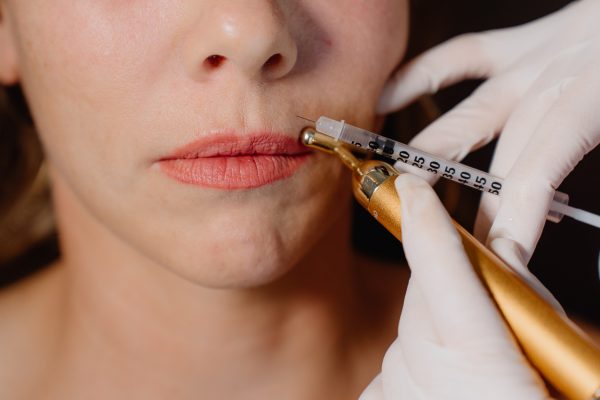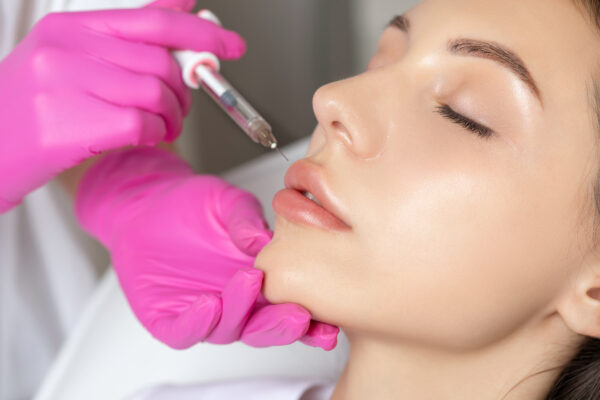If you’re considering dermal fillers for the first time, or if you’ve had treatments before, you’ve probably seen scary social media posts or videos about “filler migration.” Maybe it’s a puffy upper lip that looks unnatural, or a lump under someone’s eye that wasn’t there before. It’s enough to make anyone second-guess their appointment.
Here’s the truth: Yes, filler migration can happen. However, it is not inevitable. It is also far more preventable than many people realize, especially when you’re in the care of a skilled, licensed injector.
In this blog, we’ll walk you through everything you need to know about filler migration: what it is, what causes it, how to recognize it, and most importantly, how to avoid it. Whether you’re new to injectables or reevaluating after an unsatisfactory experience, this guide will help you make informed, confident decisions.
What Is Filler Migration?
Filler migration occurs when dermal filler shifts from the area where it was originally placed and moves into adjacent tissue. Instead of staying localized, the product spreads or settles into unintended areas, resulting in a puffy, overfilled, or distorted appearance. This can be particularly noticeable when filler migrates above the lip line, creating the look of “duck lips,” or when it settles into the under-eye area, causing bulging or swelling that doesn’t blend naturally with surrounding skin.
The idea of filler migration has gained attention on social media, where dramatic before-and-after photos or videos can spark concern. But the truth is, filler migration is far less common than it seems, especially when performed by an experienced injector using proper technique and product selection.
Migration is rarely about the product alone. It usually stems from one or more of the following: incorrect injection depth, using too much filler, overfilling too frequently, or using a product that isn’t suited for the movement level of a particular area.
Common areas where filler migration is more likely include:
- Lips, especially the upper lip, where frequent motion from speaking, eating, and smiling can affect placement
- Tear troughs (under-eye area), where thin skin and delicate structures require extra precision
- Nasolabial folds, where filler can shift or bulge if overcorrected
- Smile lines and marionette areas, which move constantly with facial expression
The good news? Migration is preventable with expert placement, conservative volume, and the right product for the job. It’s also manageable if it does occur, especially when you have a trusted provider guiding you.
What Causes Fillers to Migrate?
Several factors contribute to filler migration, and understanding them helps you avoid the risk. Here’s what you need to know:
Product Placement Errors
Migration is most often the result of improper placement. Fillers can travel into surrounding tissues when injected at the wrong depth or into overly mobile areas. High-movement zones, like the mouth and eyes, require a precise, skilled hand.
Injectors must understand not just skin but also muscle and tissue anatomy. For example, placing filler too close to the orbicularis oris muscle around the lips can lead to an overfilled, migrated look commonly referred to as “duck lips.” With Botox, an injector must also know where muscles pull to avoid unwanted drooping or asymmetry.
Type of Filler Used
Not all dermal fillers are created the same, and the specific product used can play a big role in whether migration occurs. Fillers vary in their texture, thickness, and flexibility, and these differences affect how well they stay in place after injection.
Softer, more flexible fillers — like those often used in the lips or under the eyes — are designed to move with your natural facial expressions. While that’s great for maintaining a soft, natural look, it also means they are more likely to shift over time if not placed correctly or used in high-movement areas.
A key factor in how stable a filler is involves cross-linking, which refers to how tightly the molecules of hyaluronic acid (HA) are bound together. The more cross-linked a filler is:
- The firmer and more cohesive it becomes
- The longer it tends to last
- The less likely it is to migrate
On the other hand, lightly cross-linked fillers spread more easily and are better suited for delicate areas — but only when used by someone who understands the ideal depth and placement for each product. Using a very soft filler where a firmer one is needed (or vice versa) increases the chances of filler moving into unintended areas.
In short, choosing the right filler for the treatment area is just as important as how it’s injected. An experienced injector will know exactly which product suits your unique anatomy and goals.
Overfilling and Frequent Touch-Ups
When injectors add too much filler, or “layer” new product on top of old filler without dissolving it first, the tissue can’t hold the volume. This pressure can push the product into nearby areas. Rushing back for touch-ups before the filler has settled can also disturb placement.
Natural Facial Movements
Your face moves constantly—smiling, talking, frowning, chewing. Over time, this motion can encourage product to shift, especially in areas like the lips and perioral region. That’s why technique and timing are so important in preventing long-term issues.
How to Tell if Your Filler Has Migrated
Not sure if what you’re seeing is migration or just swelling? Here are some common signs:
- Puffiness or swelling above the upper lip line
- Bulges or unnatural fullness in untreated areas
- Uneven surface or firm, lumpy textures
- Distorted smiles or facial expressions
- A feeling that something “doesn’t look quite right” compared to your initial results
If any of this sounds familiar, don’t panic. Migration doesn’t necessarily mean something has gone wrong. It just means your filler may need to be evaluated—and possibly adjusted or dissolved.
How to Prevent Filler Migration
The best approach to filler migration is prevention. Here’s how you and your provider can work together to keep things safe and beautiful:
Choose an Experienced Injector
This cannot be overstated. Filler is a medical treatment, and it requires medical training. At Be You Medical, all injectables are performed by licensed providers under the medical direction of Dr. Selene Castrejon. Every treatment is guided by a deep understanding of facial anatomy, movement, and balance.
We use:
- The right filler for the area
- The right amount of product
- The right technique for lasting, natural results
Start Conservatively
More filler is not always better. In fact, starting small and gradually building often yields better results. This approach reduces the risk of overfilling and helps maintain facial harmony. We’ll always evaluate old filler before adding more—and advise you if something should be dissolved before treating again.
Give It Time Between Treatments
It’s tempting to want immediate results, but your skin and tissue need time to settle. We generally recommend waiting at least two to four weeks between treatments or touch-ups. This allows swelling to subside and prevents disruption of the initial placement.
Follow Aftercare Instructions
Following your injector’s aftercare instructions carefully can help reduce the risk of complications like migration. Avoiding excessive pressure, massage, or exercise too soon after treatment can make a big difference in how your filler settles.
Can Migrated Filler Be Corrected?
Yes, in most cases, filler migration is not permanent and can be corrected safely.
Hyaluronidase Can Dissolve HA Fillers
If the filler is made of hyaluronic acid (like Juvéderm or Restylane), an enzyme called hyaluronidase can be injected to dissolve it. This treatment is very effective for softening or removing unwanted or migrated filler. It works within hours and resets the area so your provider can start fresh.
When to Call Your Injector
If you suspect migration or just feel like something is off, don’t wait. A reputable provider should welcome the opportunity to assess and guide you. At Be You Medical, we frequently help patients correct fillers that were done elsewhere. We’re here to support you, not shame you.
Be You Medical’s Approach to Safe, Beautiful Results
At Be You Medical, your safety and satisfaction are always the top priorities. Whether you’re getting filler for the first time or coming in for correction, our approach is built on professionalism, transparency, and care.
Here’s what sets us apart:
- Expert Injectors: All treatments are performed by highly trained professionals under the medical direction of Dr. Selene Castrejon.
- Personalized Plans: Every face is different. We tailor each treatment to your anatomy, skin condition, and aesthetic goals.
- Natural Results: Our philosophy is less-is-more. We enhance your features without overdoing it, so you still look like you.
- Medical-Grade Safety: We use only FDA-approved products sourced from certified distributors and perform treatments in a sterile, clinical environment.
- Patient Education: We walk you through every step of the process, explaining your options clearly and answering your questions honestly.
- Correction-Friendly: If you’re coming to us after a less-than-ideal experience elsewhere, we’ll never judge. We offer skilled, compassionate care to help restore balance and confidence.
We’re not here to rush you or push you into anything. We’re here to support your journey toward natural, long-lasting results that feel like you, but refreshed.
Sources:
Shape. Lip Filler Migration: Can You Prevent It? https://www.shape.com/lifestyle/beauty-style/lip-filler-migration
Harley Academy. How to Manage and Correct Uneven Lip Filler Results. https://www.harleyacademy.com/aesthetic-medicine-articles/how-to-manage-and-correct-uneven-lip-filler-results/
American Academy of Facial Esthetics. Filler Migration. When is it Time to Start Fresh. https://facialesthetics.org/filler-migration-when-is-it-time-to-start-fresh/




